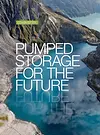Pumped storage in Australia
Pumped Storage for the Future
What is the future role of pumped storage and how can this technology contribute to Sustainable Development Goals? A short glimpse of the current market situation.
Pumped storage hydropower plants are well proven as the most cost-effective form of energy storage to date. They offer state-of-the-art technology with low risks, low operating costs and balance grid fluctuations through their high operational flexibility, allowing the successful integration of intermittent renewable power. Thus, they significantly contribute to a clean energy future.
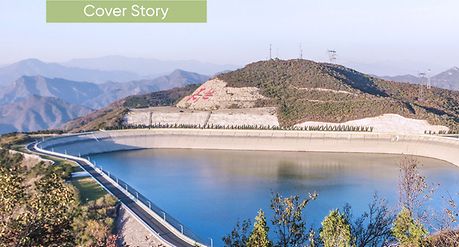
PSPP Shi Shan Ling, China
The technology was first applied in Zurich, Switzerland, in the early 1890s, when a local river was hydraulically connected with a nearby lake via a small pumped storage plant. Pumped storage hydroelectric projects have been commercially providing energy storage capacity and grid stabilizing benefits since the 1920s. Thereafter the technology was significantly improved and developed. In the 1970s and 1980s, concerns about grid and supply security, as well as base load balancing requirements, induced a boost for pumped storage plants.
In 2015, the Paris Climate Agreement (COP21) set global goals to mitigate global warming. Many countries have aligned their energy policies to reduce greenhouse gases emissions and to push power generation from renewable resources. This triggered an increasing need for energy storage. Currently, pumped storage is the primary technology for energy storage services, balancing variable power production, serving as buffer and providing predefined energy supply, thus ensuring grid stability and reducing the risk of black-outs when critical disparities occur between supply and demand.
Today more than 150 GW of pumped storage capacity is installed throughout the world. In 2016 about 6.4 GW – nearly twice the amount installed in 2015 – was added worldwide. A further 20 GW of pumped storage capacity is currently under construction across the globe.
Worldwide distribution of pumped storage capacity (GW) at the end of 2016

Pumped storage hydropower capacity (GW) in operation
Source: IHA, International Hydropower Association, 2017 Key Trends in Hydropower
This confirms that hydropower, and pumped storage especially, represents a substantial part of the renewable power sector. Among others China is trendsetter, having implemented the necessary frameworks to reach a 40 GW of pumped storage capacity by 2020 as part of an energy development plan (see article Fengning 2).
The benefits of pumped storage such as balancing volatile renewable energy sources and supplying security and grid stability are a most welcome contribution to every grid. For small and islanded grids especially, pumped storage hydropower is an ideal partner when independence from fossil fuels can be achieved. For example, on El Hierro, one of the Spanish Canary Islands, a small pumped storage power plant has been combined with a wind power park. Together they are providing sufficient and stable power supply which even allows energy exports to neighboring islands.

Comparison of electricity storage technologies. PSP is the only form of bulk electricity storage technology that today offers high efficiency and high capacity at low cost. ‘Round-trip efficiency’ is the electrical efficiency of the whole storage cycle from electricity to electricity at the grid connection point.
Other energy storage technologies
Along with pumped storage, there are other energy storage technologies in commercial use, mainly batteries based on lead sulfur, lithium ion, sodium sulfur and sodium nickel chloride. They are overall proven technologies with fast response times, applicable almost everywhere and allowing easy interlinking with intermittent renewable technologies. However, batteries have a shorter lifetime, while issues such as sourcing materials for large scale implementation and environmental hazards in mining, production, and recycling represent challenges. Today, only about 2 GW of battery storage capacity is installed globally (in comparison with 150 GW of PSP). Nonetheless, batteries are going to be deployed at scale and in the future electricity landscape, batteries and pumped storage will both remain essential technologies.
Pumped storage technologies
At its heart pumped storage power plant technology sees water pumped to a higher elevation reservoir when there is a surplus of electricity. This water is then released into lower elevation reservoirs to generate electricity when needed.
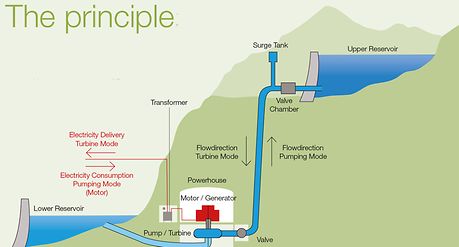
Pumped storage plants pump water to higher elevation reservoirs at times when there is a surplus of electricity, to then release this water into lower elevation reservoirs to generate electricity when needed.
There are three basic designs of pumped storage technology currently available, depending on the services required.
Reversible pump-turbines with a fixed speed motor-generator supply full flexibility in turbine operation. Pump operation is restricted to on or off. Operating a set of pump-turbines in parallel (usually 4-6 units) allows more flexibility in pump mode by adjusting the discharge and power in discrete steps.
Ternary sets with a separate pump and turbine and with fixed speed motor-generator provide full flexibility in both turbine and pump mode. Ternary sets are suitable for very fast (within a few seconds) change-over between modes. With an optional hydraulic short-circuit, these types of units are able to adjust discharge and power also in pump mode.
Reversible pump-turbines with variable speed motor-generator provide infinitely adjustable discharge and power in both turbine and pump operation, plus enhanced grid services like virtual inertia.

ANDRITZ Hydro’s long history
ANDRITZ Hydro supplied the generating units for the world’s first commercial pumped storage plant – Niederwartha in Germany in 1929 – and has continued to provide groundbreaking technology ever since. For example, the storage pumps of Provvidenza (Italy, 1949) as well as Limberg (Austria, 1954) were the world’s largest at the time of the contract awards. Germany’s largest pumped storage plant, Goldisthal, was the first variable-speed pumped storage plant outside Japan.
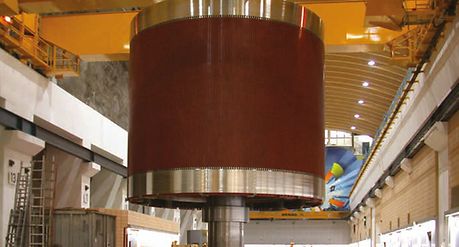
PSPP Goldisthal, Germany
Since Niederwartha, ANDRITZ Hydro has delivered about 500 pumped storage units with a total capacity of about 40,000 MW. The company has been involved in major projects around the globe, like Tianhuangping and Tongbai in China, Northfield, Muddy Run and Castaic in the USA, Edolo and Presenzano in Italy, Malta-Reisseck in Austria, Drakensberg in South Africa and Aldeávila in Spain, as well as Vianden in Luxembourg – the largest pumped storage plant in Europe and where unit #11 was recently commissioned. For Lower Olt in Romania ANDRITZ Hydro supplied the largest low-head Bulb type pumped generating units in the world. Currently, ANDRITZ Hydro is executing Gouvães in Portugal and has recently signed a contract for two speed-variable generating units for Fengning II in China, which will become the largest pumped storage plant in the world when completed (see also the articles about Alto Tâmega, Fengning 2 and Vianden).

PSPP Foz Tua, Portugal
Research and Development
Constant evaluation and development is necessary to meet changing customer requirements. ANDRITZ Hydro engineers are permanently refining technologies such as adjustable speed and closed-loop systems – projects without a continuous connection to a natural water body outside the hydraulic scheme. Customized designs can also be deployed in special locations, such as in the marine environment with ultra-low heads like in Swansea Bay, Wales/UK, for example.
Today, the focus is on smooth and stable operation, as well as an extended operational range, dynamic operations and high reliability and flexibility. This is despite the requirement for frequent mode changes, rapid load changes and quick change-overs between pumping and generating. Improved structural integrity of the units ensures a long service life.
Pumped storage is a proven, low-risk technology with high efficiency. It benefits from long asset lifetimes and shows lower operating costs than any other technology that can provide similar services. By successfully integrating intermittent renewable generation resources into the grid pumped storage can thus contribute significantly to a clean energy future.

El Hierro (Gonora del Viento), Spain
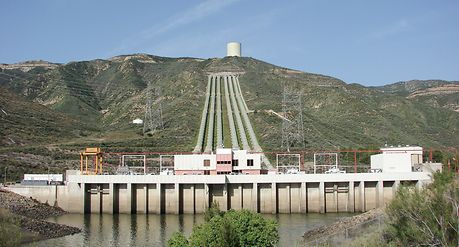
PSPP Castaic Los Angeles County, California, USA
Benefits of pumped storage:
- Best-proven, low-risk technology
- Balancing volatile renewable energy generation with demand
- Managing grid bottlenecks
- Supporting grid stability by virtue of a quick response to changing demand or sudden outages
- Contributing to grid stability by increasing grid inertia and providing black start capability
- Very long facility lifetime
Author: Alois Lechner



